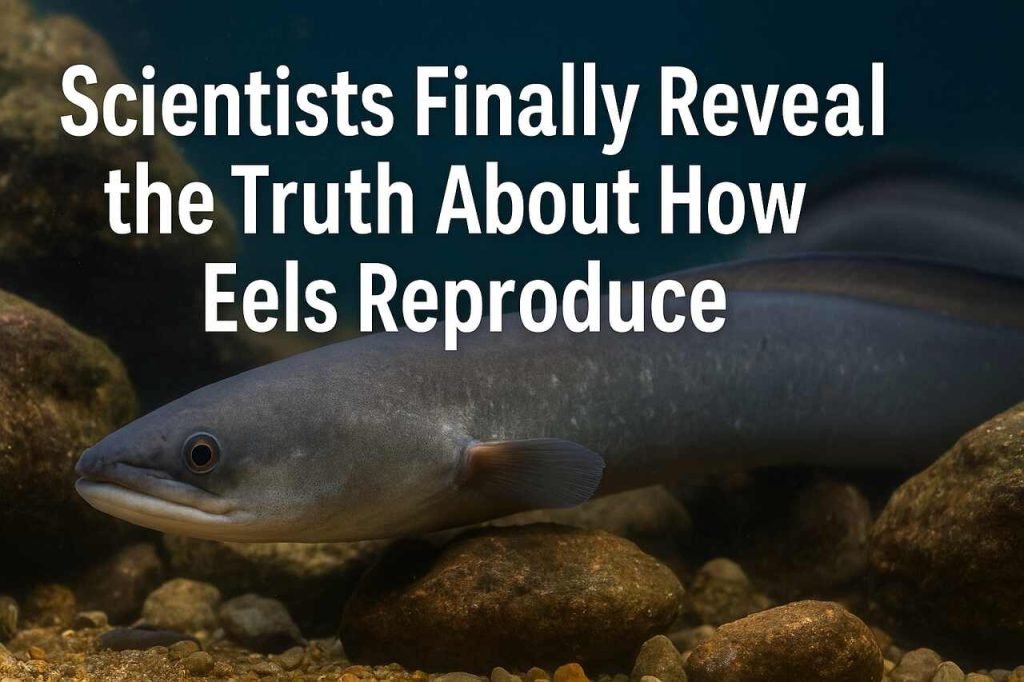Eels have hidden reproductive organs that develop only during migration to their deep-sea spawning grounds. Scientists recently confirmed where and how eels reproduce, solving a biological mystery and paving the way for breakthroughs in eel conservation and aquaculture.
What Are the Reproductive Organs of Eels?
Internal Gonads and Their Function
Eels possess internal gonads, including ovaries in females and testes in males. These reproductive organs remain dormant and underdeveloped throughout most of the eel’s life. They enlarge and become functional during the eel’s oceanic migration to the Sargasso Sea.
Dormancy and Activation
- Gonadal Dormancy: Gonads are inactive during the yellow eel stage.
- Hormonal Activation: Gonadotropins and sex steroids like estradiol trigger gonad development.
- Maturation Signal: Environmental cues like temperature and salinity trigger the hormonal cascade.
How Do Eels Use Their Organs to Reproduce?
External Fertilization During Migration
Eels reproduce via external fertilization after a long transoceanic migration. Gonads mature en-route, and eels release eggs and sperm into the ocean, fertilizing externally.
Semelparous Reproductive Strategy
Eels are semelparous, meaning they spawn once and die. This strategy focuses energy on a single, final reproductive effort.
Spawning in the Sargasso Sea
Both European and American eels migrate thousands of kilometers to the Sargasso Sea, where spawning occurs in deep, saline waters.
- Egg Release: Females lay millions of buoyant eggs.
- Sperm Dispersal: Males release sperm simultaneously for fertilization.
- Post-Spawning Mortality: All adults die shortly after gamete release.
What Happens After Spawning?
Leptocephalus Stage
Eggs hatch into transparent, leaf-shaped larvae known as leptocephali, which drift on ocean currents.
Metamorphosis Into Juvenile Stages
- Glass Eels: Leptocephali metamorphose into smaller, transparent eels.
- Elvers: Glass eels develop pigmentation upon entering freshwater.
- Yellow Eels: Grow and mature over several years in rivers/lakes.
- Silver Eels: Undergo silvering, organ degeneration, and start ocean migration.
What New Discoveries Solved the Mystery?
Historical Clues from Johannes Schmidt
In the early 20th century, Johannes Schmidt tracked eel larvae to the Sargasso Sea, suggesting it as the spawning ground.
2022 Satellite Tagging and Confirmation
Researchers tagged mature eels and tracked their migration. Confirmed movements toward the Sargasso verified the spawning location for the first time.
- Long Distance: Over 5,000 km in some cases.
- Eye Enlargement: Vision adapts for deep-sea navigation.
- Organ Degeneration: Digestive tract regresses to focus energy on reproduction.
Can Eels Reproduce in Captivity?
Hormone Induction for Gonadal Development
Scientists use GnRH analogues and carp pituitary extracts to stimulate gonadal development.
Japan’s Breakthroughs in Eel Breeding
Japanese researchers achieved full eel life-cycle reproduction using environmental simulation and hormonal therapy.
European Innovation in Artificial Maturation
Institutions like Glasaal Volendam in the Netherlands are pioneering eel aquaculture using artificial maturation.
- Challenges: Larvae are fragile, require complex diets.
- Progress: Survival rates improving with customized feeding protocols.
Why Was Eel Reproduction a Mystery for So Long?
Challenges to Observing Natural Reproduction
- Deep-Sea Spawning: Spawning occurs thousands of kilometers offshore, inaccessible for direct observation.
- Reproductive Invisibility: Gonads hidden and inactive until final migration.
- Complex Lifecycle: Eels transition between freshwater and marine environments, complicating study.
Lifecycle Summary Table
| Stage | Location | Description |
| Egg | Sargasso Sea | Fertilized externally, buoyant and spherical |
| Leptocephalus | Atlantic Ocean | Transparent larva, drifts with ocean currents |
| Glass Eel | Estuaries | Develops pigmentation, begins upstream migration |
| Elver | Rivers | Juvenile stage, active feeding and growth |
| Yellow Eel | Inland waters | Maturation over years |
| Silver Eel | Rivers to ocean | Gonadal development, prepares for spawning |
Conclusion
Eels have internal reproductive organs that mature only during their final migration to the Sargasso Sea. Scientific advancements, including satellite tagging and hormone-based breeding, have finally revealed the full reproductive cycle of eels. These breakthroughs hold promise for conservation and sustainable aquaculture.
FAQs
Do eels have reproductive organs?
Yes, but they remain hidden until sexual maturity.
Where do eels reproduce?
In the Sargasso Sea, a remote region of the Atlantic Ocean.
Can eels reproduce in captivity?
Yes, through hormone induction and environmental simulation.
Why can’t eel reproduction be observed naturally?
It occurs deep in the ocean, far from coastlines and at great depths.
How long do eels live before they reproduce?
Typically 6 to 30 years depending on species and environment.
What is a leptocephalus?
A transparent, ribbon-like larva that hatches from eel eggs and drifts in ocean currents.
Discover more exciting reads on our blog — you won’t want to miss them!
